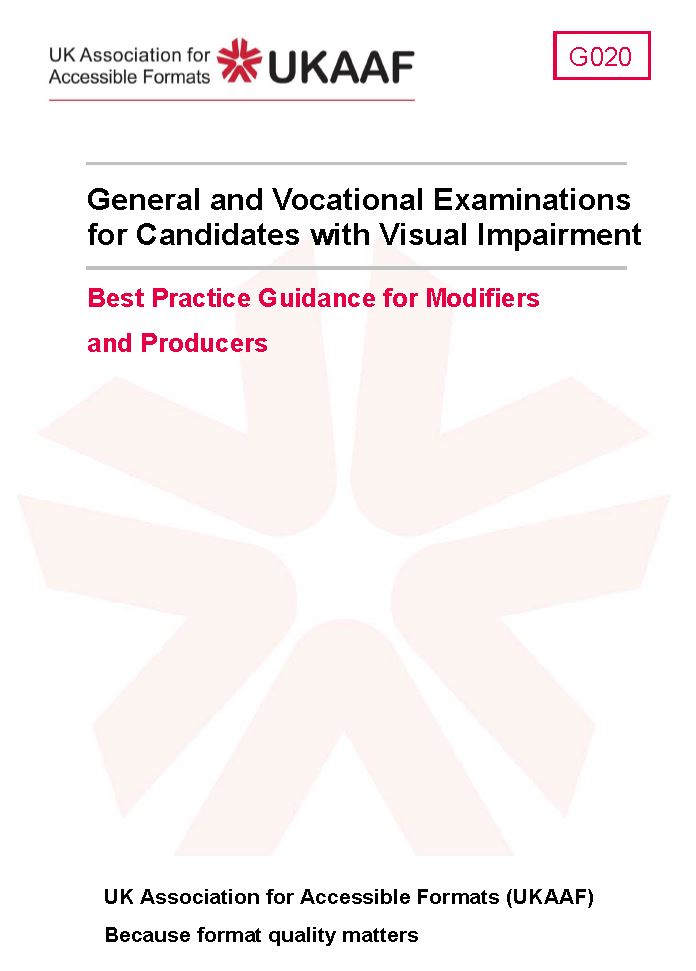- The purpose of simplifying the visual material is to reduce visual complexity so that pupils with visual impairments can demonstrate their knowledge and understanding of the subject content without having to struggle to access the information.
- Modification of examination papers for General Qualifications is carried out according to a document produced by UKAAF called "Best practice guidance for the modification and production of examination papers for candidates with a visual impairment".
- The Rules of Unified English Braille (2013) should be followed for braille examination modification.
- Visually based information such as diagrams, images and graphical forms need to be modified to make them accessible.
- Wherever possible, visual material should be retained in its original form. Sequence and numbering should be kept as per the original.
- Modification involves professional judgement and not everyone will agree with the modifications adopted in every paper. The important thing is to understand the range of modifications that may be used and to ensure that candidates are familiar with them.
Preparing candidates
An understanding of how examination papers are modified may help you to determine whether a modified paper may be suitable for a candidate or when preparing candidates for assessment using a modified paper.
You may also find modification methods to be useful when producing your own everyday materials.
This activity gives an introduction to how various question types may be modified for VI candidates. Please note that centres should not modify their own exam papers — this work is done by specialist modifiers on behalf of the Awarding Organisations.
Guidance
The guidance provided in this activity is designed to give you an introduction to some of the concepts involved in modification and is by no means comprehensive. For more detailed guidance you can refer to the following.
Modification of examination papers for General Qualifications is carried out according to a document called "Best practice guidance for the modification and production of examination papers for candidates with a visual impairment", which is available on UKAAF's website.
Note: this document is in the process of being updated at this time [September 2020].
The RNIB also published 'Well Prepared!' which is an illustrated guide to modifying examination, assessment and curriculum materials for blind and partially sighted learners. This book is now out of print but can be downloaded from RNIB Bookshare (free registration).
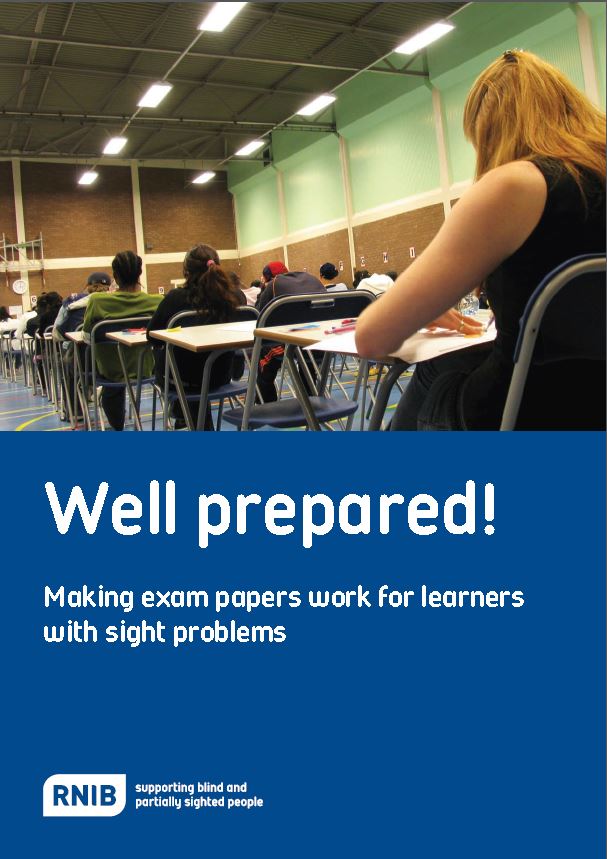
Modification by the examination centre
For reasons of resourcing and cost it may not be possible to obtain papers in the candidate's exact preferred format. In such cases further modification may be required within the examination centre.
You will need permission to carry this out.
Early opening
Rules vary about opening papers early to make such changes, depending on the nature of the examination. Any changes made to the presentation of a paper at a local level should not affect the content of the questions unless these have been approved by the awarding body. Making changes to papers without explicit permission constitutes malpractice and may invalidate the assessment.
Coloured paper
For candidates who have difficulty with the contrast between print and background it may be appropriate to gain permission in advance to open the paper early and make a high quality photocopy of it onto their preferred colour of paper.
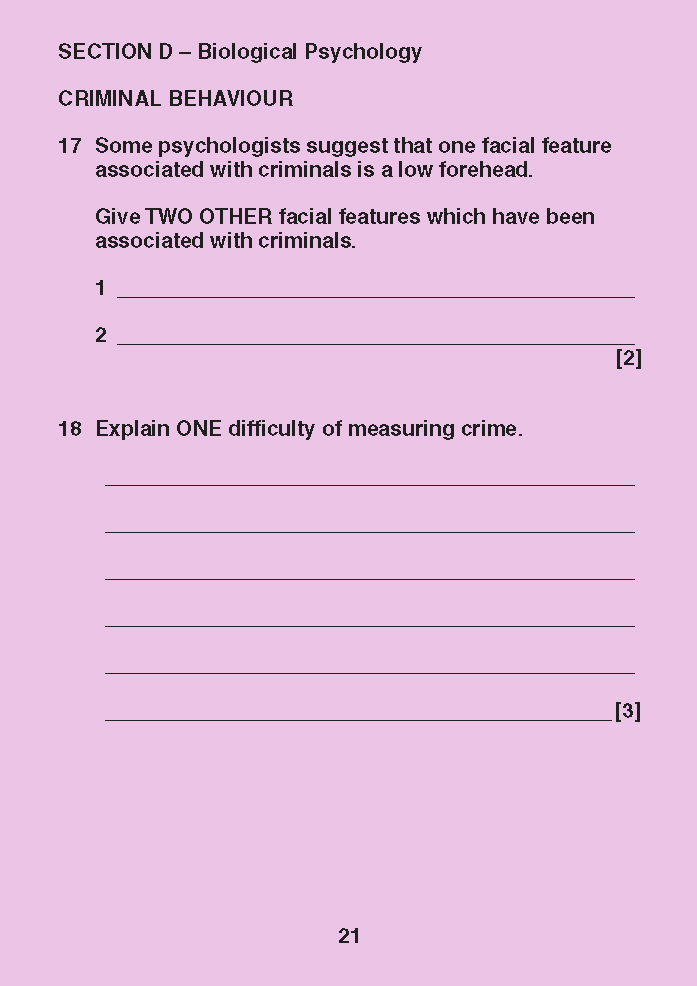
Visual cues
Examination papers use a lot of visual cues to assist in making the assessment clear and accessible to candidates. These include:
- layout and numbering of the questions
- separation of questions
- format of text
- use of emphasis in text
- reference to separate source materials
- format of source materials eg tables
- spaces, lines and boxes for the candidate response
- specific instructions for how to proceed
To make the paper accessible to candidates with visual impairment, modifications and alternate approaches are needed.
Additionally, a lot of examination papers contain visually based information such as diagrams, images and graphical forms that also need to be modified to make them accessible.
Overall approaches
Section 4.3 of the 'Best Practice Guidance for Modifiers and Producers' relates to producing modified enlarged print papers. Take a look at pages 64 - 69 and have a go at the following task.
What approaches should be taken to modifying visual material?
Select all of the correct statements.
Select the 'reveal' button to get a brief review of these points.
The answer will appear after the reveal button.
Diagrams, images and graphs
Printed information is often presented in a 'graphical' format rather than textual. For example;
- diagrams
- tables
- graphs (line, bar, scatter etc)
- photographs and drawn images
This is not only apparent in mathematics and science but also where data is commonly used such as geography, history and psychology. The majority of examinations will contain some form of (non-textual) visual material, whatever the subject.
The most common type of modification is to simplify the visual material. The purpose of this approach is to reduce visual complexity so that pupils with visual impairments can demonstrate their knowledge and understanding of the subject content without having to struggle to access the information.
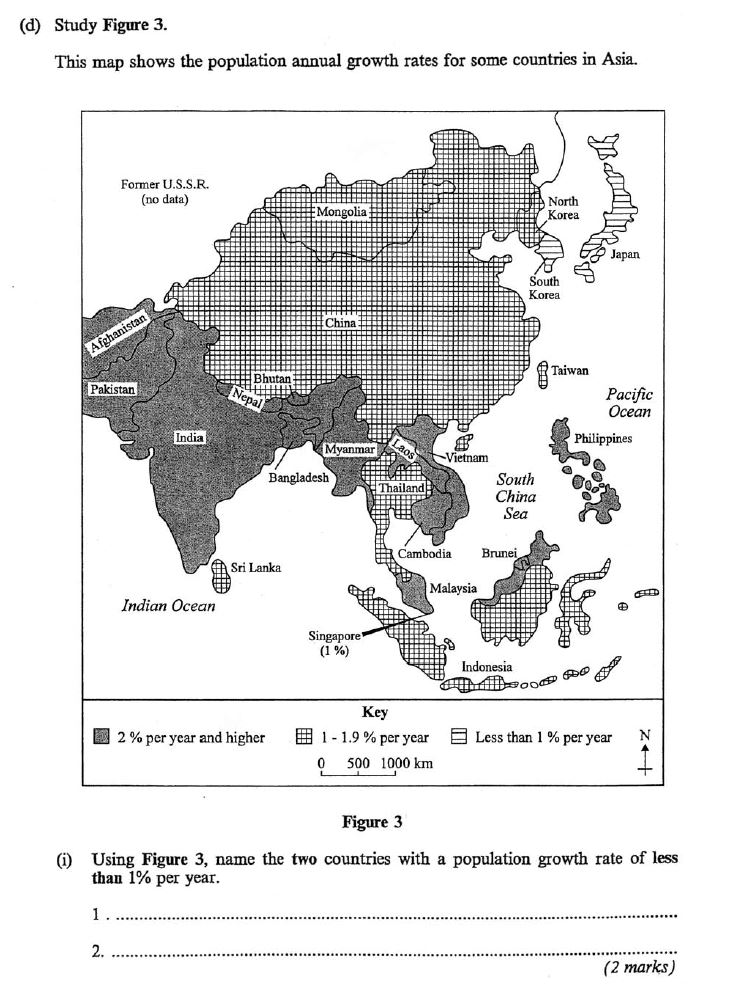
Here are a few ways to simplify visual material.
Remove unnecessary detail
Some pictures or diagrams include details for the sake of realism or real-world context, which are not needed to answer the question. The example below shows a tube of glue but the question only requires the candidate to identify the hazard signs on it.
Explore this question to identify possible issues for VI candidates.
Select the various parts or use the 'next' button to identify items that some VI candidates might find difficult.
Original version
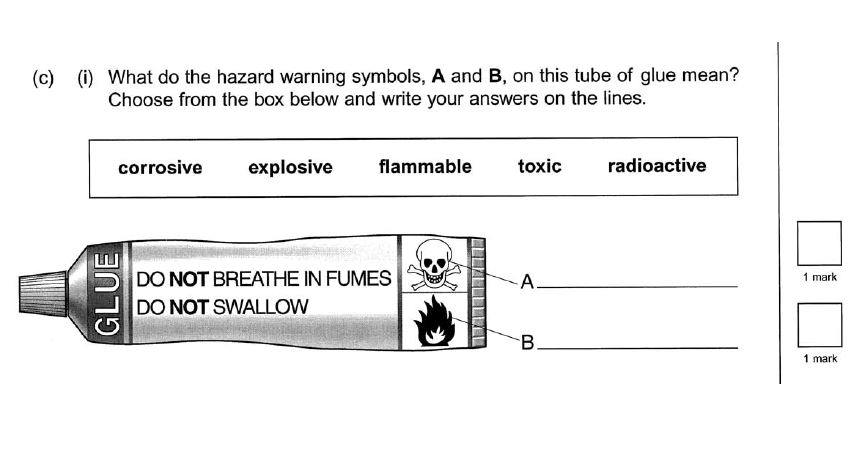
Select 'next' or explore the diagram to identify items that some VI candidates might find difficult.
The feedback from using the 'next' button will appear in the text box above.
You can compare a modified version of the same question.
Modified version
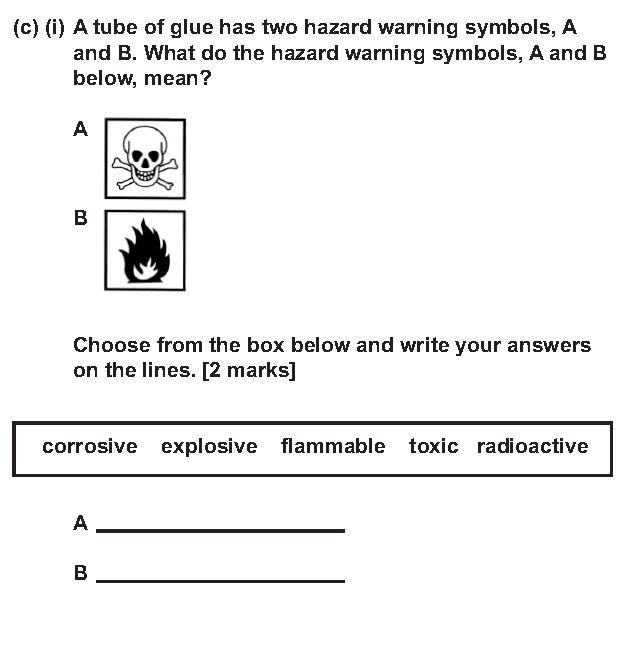
Modifications
- The picture of the tube and the word "GLUE" have been removed, leaving just the symbols, ie the part of the original picture that the question text refers to. The modified version is testing the same knowledge, and the rest of the tube of glue is unnecessary detail.
- The question text and pictures have been rearranged into a more logical order to reduce visual scanning, ie introduction, question, pictures, words to choose from and place to write them.
- The wording "DO NOT BREATHE IN FUMES" and "DO NOT SWALLOW" is less clearly unnecessary. "Fumes" might remind a pupil of fires or explosions; "Do not swallow" might trigger a pupil to think of poison and toxicity.
Related subjects
- Any
Simplify graphs
Line graphs, scatter graphs and bar charts are very common in many subjects, so pupils should have had plenty of practice before meeting one in an exam. This example illustrates some of the aspects that must be considered to make a line graph accessible.
Original version
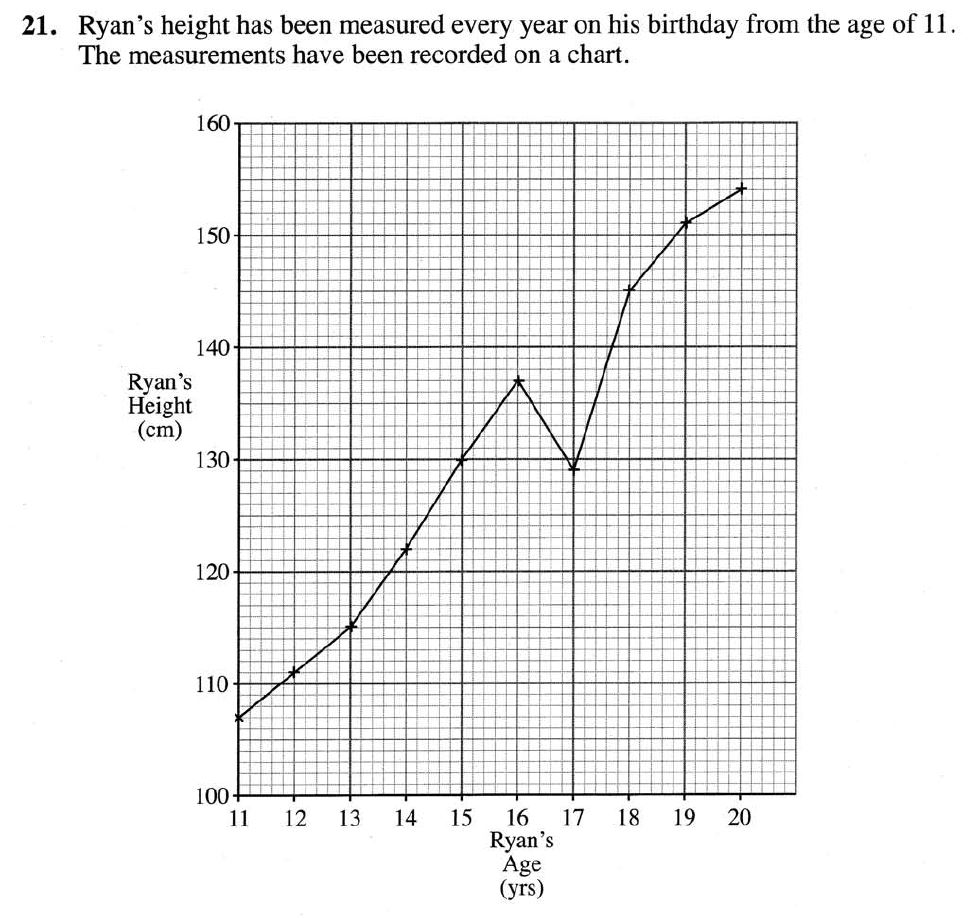
Compare this modified version of the same question.
Modified version
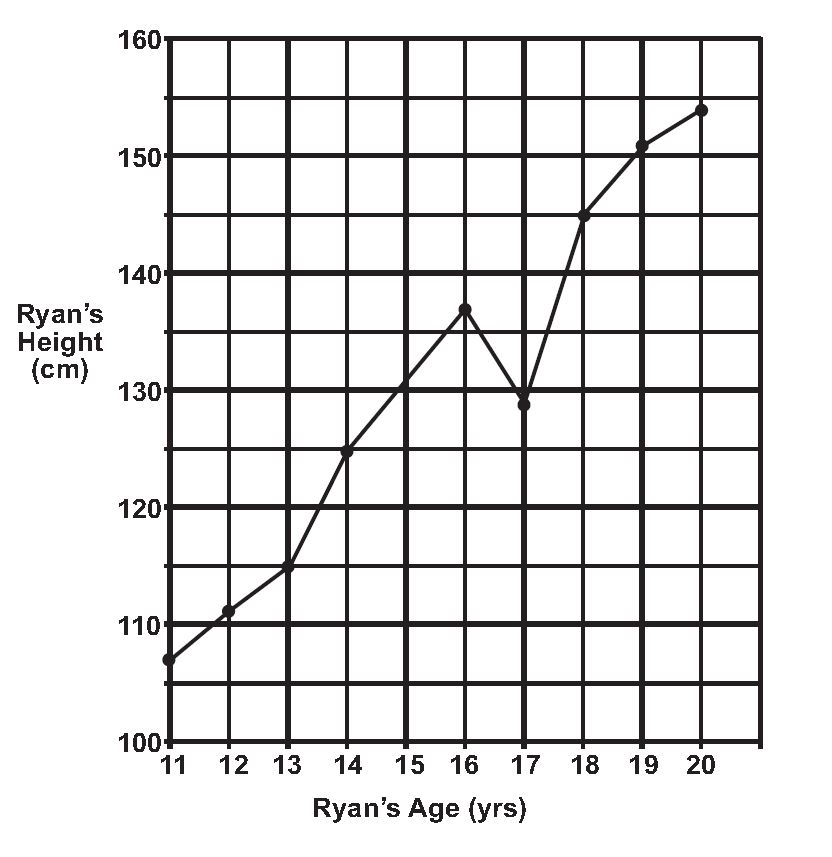
Modifications
- Most of the minor grid lines have been omitted.
- The crosses at the data points have been replaced by large dots.
- The data point at height=125 cm has been moved from 14.4 years to 14 years, ie onto a grid intersection.
- The graph has been moved out of the question to a separate diagram booklet.
Related subjects
- Mainly Maths and Science but many other subjects too
Supplement with a written explanation
Some tasks may require additional written explanation to ensure that a pupil with a visual impairment grasps what is happening in a picture or diagram, even if this has also been simplified, or enlarged as in the example below.
Original version
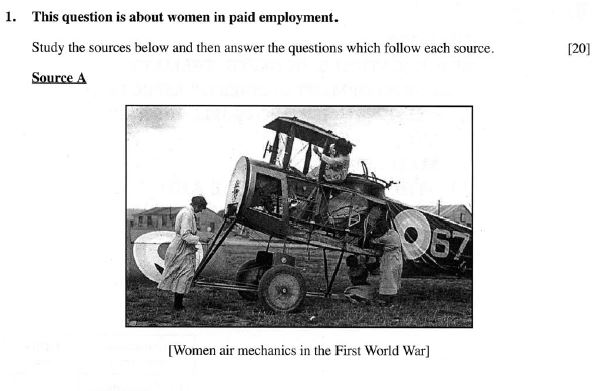
Compare this modified version of the same question.
Modified version
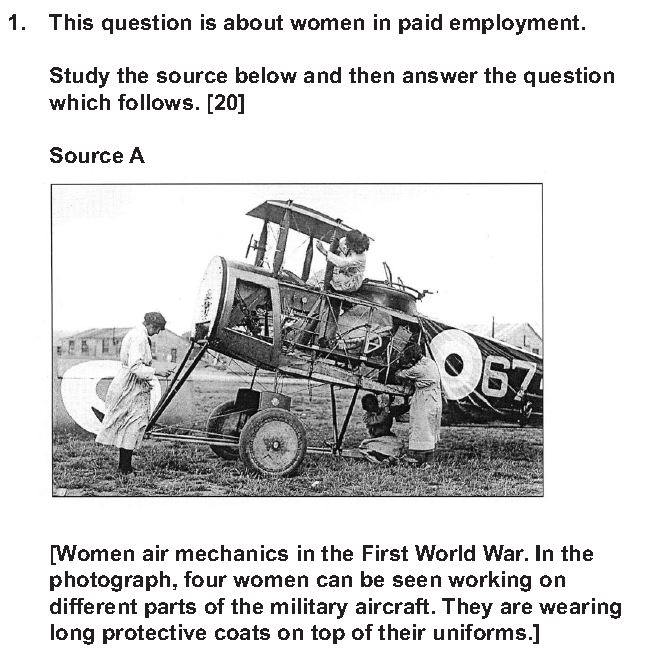
Modifications
- A short description of the picture has been added. The question isn't directly about just the picture; the picture and its associated text act as prompts for material that has been studied during the course.
- The picture was enlarged 50 per cent in each direction.
- The picture clarity was possibly improved for the modified paper, but that might only have been an accident of the photocopier!
Related subjects
- English, humanities and many others
Other considerations
High quality reproduction should be used, as it was in the original and modified questions
The paragraph spacing may need to be increased, which is appropriate for extended passages of text.
Picture quality is difficult to ensure if, for example, a paper is photocopied for a practice paper, or during early opening for a candidate who requires a different print size. "Photo" or "picture" settings on the photocopier should be used.
Replace with a written description
The photograph below is used to accompany a newspaper article, which is reference material for an English examination question.
Have a go at writing a paragraph to replace the photograph.
Original version
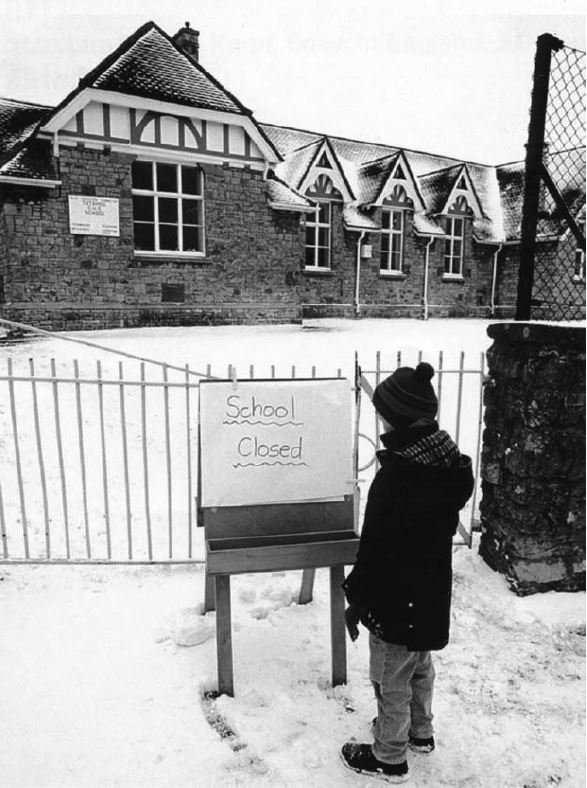
Description
Type your description in the area below.
Your input won't be saved. If you wish to keep it you could use copy and paste.
Select 'model answer' to see an example description.
The answer will appear after the reveal button.
Other approaches
The above examples show a few of the general techniques that can be used to modify visual materials:
- Remove unnecessary information
- Simplify graphs
- Supplement with a written explanation
- Replace a picture or diagram with a written description
Consider these other approaches:
- Replace a picture or diagram with a real item or model, and cut-outs
- Remove a picture or diagram because it is unnecessary (eg giving context)
- Reduce the amount of information if it is not needed
- Adjust a scale diagram to yield answers with coarser accuracy needed (eg to nearest .5cm rather than nearest mm)
- Increase the tolerance in the mark scheme for direct measurement tasks (eg measuring and angle or distance on a diagram
- Replace an inherently visual question with a non-visual equivalent
- Replace a drawing task where the drawing is simply a means of communicating a response (ie where drawing ability is not the skill being assessed)
- Allow different answers that reflect usual, effective or preferred ways of working of a VI candidate (eg which method of input to a PC would be most effective for selecting from a menu)
- Convert a 3D diagram to a 2D diagram or several 2D diagrams
- Clarify music stave notation by spacing out, thickening lines and standardising on tails below heads for notes)
- Simplify and clarify bar charts by adjusting shading and adding grid lines to help scanning across
A picture of a bicycle is being used here to support a question.
Original version
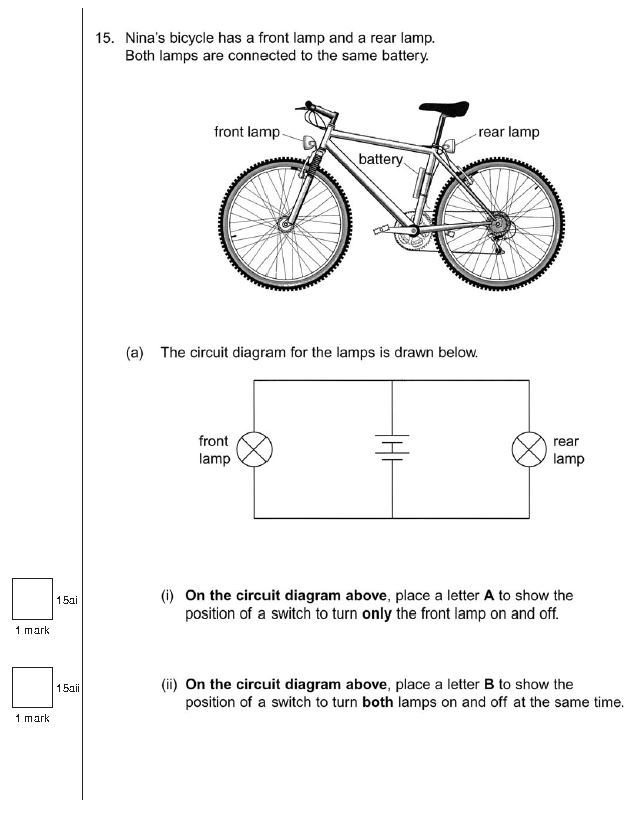
Which of the following approaches would be most appropriate to modify the question?
Modification and transcription
Like modified print papers, braille papers require modification before they are transcribed into braille. This is because the layout, format and instructions will not make sense if simply transcribed. Also, visual material such as diagrams, maps and pictures will need to be modified and labels transcribed.
Many of the principles discussed above for modified print papers will apply equally to braille papers.
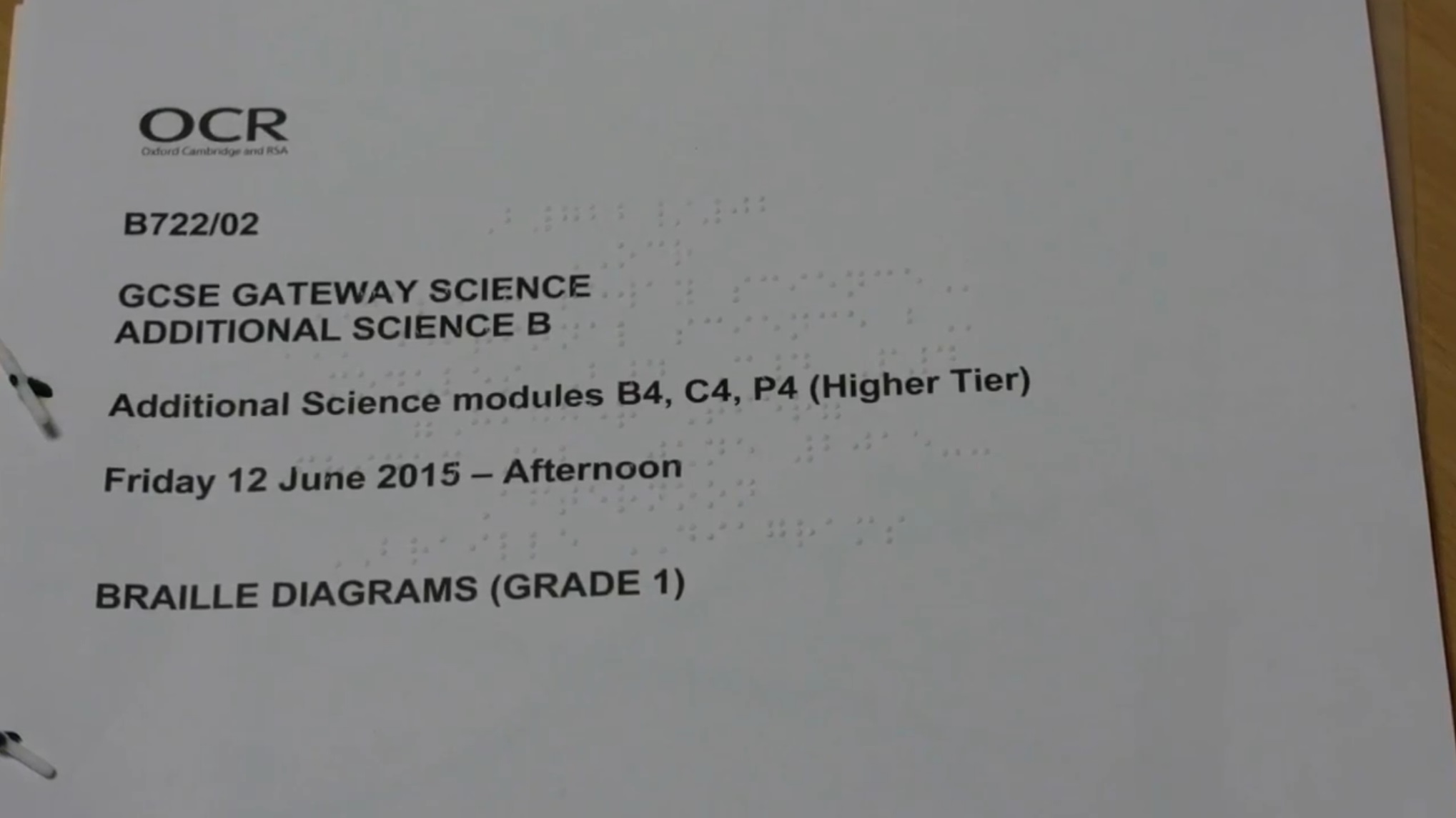
Standards
The Rules of Unified English Braille (2013) should be followed for braille examination modification. These standards are produced by the International Council on English Braille (ICEB).
The guidance is further complemented by other basic references:
- Unified English Braille - Guidelines for Technical Material (ICEB)
- RNIB guide to Using UEB for Maths
- RNIB guides to Using UEB for Science
- Additional Guidance on UEB Mathematics produced by UKAAF, which provides extra guidance for the UK
The specific guidance given in this last document, eg on layout, choice of grade 1 indicators, etc., should be followed for all mathematics exam paper transcriptions, as well as for maths expressions in science and computing papers.
The UKAAF guidance provides specific details on how braille modified papers should be produced. Familiarity with these layouts through past paper practice and adopting the conventions for course materials will help to prepare the candidate.
Print version
It is a requirement that a print version of each braille paper be produced, to assist readers, scribes and invigilators. This should be textually accurate, following the braille script and all the amendments; including 'hidden text' if it is read by the screen reader. It should be clearly headed to indicate that it is the print version of the braille paper.
A candidate who uses a computer screen reader as their normal way of working should be able to use the computer to read text in an exam.
There are also issues around the implementation of screen reader technology. Screen reader software programs are not designed to a common standard, so the facilities offered by them can vary widely. In addition, once installed a screen reader can be configured in many different ways to suit the needs and preferences of the user. Also there can be great variability in the skill level of the user, depending on the length of time they have been using a screen reader and the level of instructional expertise to which they have had access.
File formats
The screen reader version of the exam paper will generally be a PDF file for the main question text (although this will be subject to specification by the awarding body). This might be accompanied by diagrams in a medium chosen by the candidate and their exam centre, usually modified large print diagrams, or tactile diagrams on brailon or swell paper, with braille or print labels.
There might also be additional PDF, HTML or other files, as dictated by the requirements of the exam. These might include content such as a screen shot that is to be examined electronically by the candidate with their screen reader, or sources in an English Literature or History paper, where the modifier or producer judge it would be easier to have them as separate files from the questions.
It should not be taken for granted that exam papers in every subject and every type of printed material can necessarily be translated meaningfully into a form accessible via speech.
Modifications within reader version
The screen reader format may include modifications to facilitate access, such as 'hidden' text that will be spoken by the screen reader, for example alternative text descriptions for graphic images.
Print copy of reader version
A print copy of the screen reader version should always be provided for use by any staff supporting the candidate during the course of the exam. This is especially important if the candidate is reading the paper on a device without a screen, such as a QWERTY or braille notetaker.
By default the Print Transcript is just a printed copy of the screen reader document file. One addition that might be required is wording to indicate that it is a 'Print transcription of a version for use with a screen reader' if words to that effect are not included within the file. Any text that is 'hidden' in the screen reader version but will be spoken by the screen reader should also be included in the Print Transcript.
Modifiers exercise their professional judgement in order to ensure that the key principles of modification are upheld. There is no single correct way of doing this and not all teachers will agree with the modifications adopted in every paper.
The important thing is to understand the range of modifications that may be used and to ensure that candidates are familiar with them.
